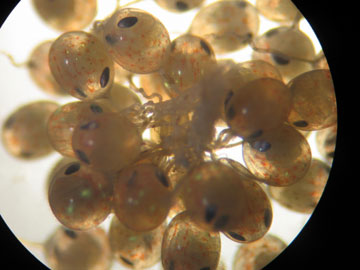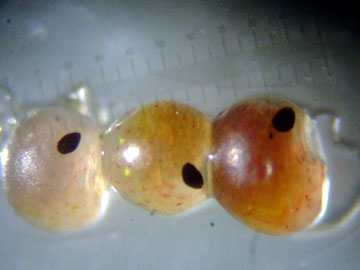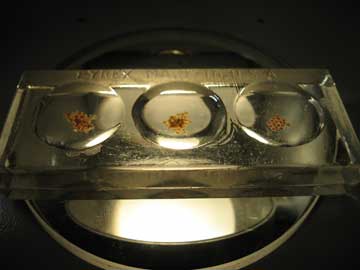 February 07, 2007
The arrivals will be newborn red and blue king crab larvae, each only about the size of a finely sharpened pencil tip. In all, more than one million king crabs are expected to hatch at the University of Alaska Fairbanks Seward Marine Center in the coming weeks. The hatch will mark an important milestone in efforts aimed at one day rebuilding wild king crab stocks around Kodiak and the Pribilof Islands. "We feel like expectant parents," said Brian Allee, director of Alaska Sea Grant and manager of the Alaska King Crab Research and Rehabilitation Program. The program was launched in 2006 at the urging of coastal communities and fishermen from Kodiak and the Pribilof Islands. "These newly hatched crab will help us understand what is needed to succeed in large-scale hatchery restoration of red and blue king crab stocks in parts of Alaska where their numbers are low," said Allee. "In the months ahead, we'll refine our understanding of the food, habitat, and growing needs of these crab." This first batch of crab will not be released into the wild, Allee said. That phase of the project is several years away, and will require a state permit following studies on the impacts of the crab on the environment and research to determine crab survival, predation, genetics, and other factors. "We don't know enough about the survival and impacts of these crab to say we are ready for a pilot release program," said Allee. "Right now, the research is focused on the mass-culturing needs." The Alaska King Crab Research and Rehabilitation Program was born out of a grassroots effort by fishermen and coastal communities to reverse a decades-long slump in wild king crab production. Red king crab stocks around Kodiak have not recovered since crashing in 1982, when commercial fishing was halted. Stocks of Pribilof and St. Matthew Island blue king crab have been low since the mid-1980s. Commercial fishing for the two distinct stocks has been closed most recently since 1999. King and other crab stocks are considered healthy and support vibrant fisheries in other parts of Alaska. Last year, 58 red and blue king crab were collected under state permits from Alaska waters around Kodiak Island and Saint Paul Island in the Pribilofs. The adult broodstock crab are under the supervision of the Alutiiq Pride Shellfish Hatchery in Seward. They are being temporarily housed and cared for at the nearby Seward Marine Center, operated by the University of Alaska Fairbanks School of Fisheries and Ocean Sciences, until the hatchery has finished repairs and upgrades to support the crab research project. After the larvae emerge from their eggs, the only appendages present are the mouthparts, which the larvae use to swim, said Brad Stevens, a former Kodiak-based federal crab biologist who now is a professor at the University of Massachusetts Dartmouth. Within a few weeks, the crab reaches the shrimp-like glaucothoe (GLOCK-O-THO-EE) stage-during which the larvae develop a tail, legs and claws. Eventually, the crab will grow to be among the largest crustaceans in the sea, Stevens said. "The most amazing thing is that these tiny creatures, only 1/16th of an inch in length, can grow to be an eight- to ten-pound giant, with claws the length of a man's arm," said Stevens. Last March, Alaska Sea Grant convened a workshop to discuss the state of scientific knowledge surrounding the mass culture and wild stock restoration of crabs. The international gathering highlighted several states and countries pursuing programs to restore depleted populations of wild crab. The workshop led to calls by Alaska fishermen and coastal communities to establish a crab mass-culture program to rebuild king crab populations in parts of the state. Following the workshop, Alaska Sea Grant established the Alaska King Crab Research and Rehabilitation Program. The program is an Alaska Sea Grant partnership with the United Fishermen's Marketing Association, the Aleutian Pribilof Island Community Development Association, the Central Bering Sea Fishermen's Association, the National Marine Fisheries Service, Alaska Department of Fish and Game, City and Borough of Kodiak, the Alutiiq Pride Shellfish Hatchery, and the University of Alaska Fairbanks School of Fisheries and Ocean Sciences. Together the partners have contributed about $226,000 to the project. Source of News:
Publish A Letter on SitNews Read Letters/Opinions
|
||


